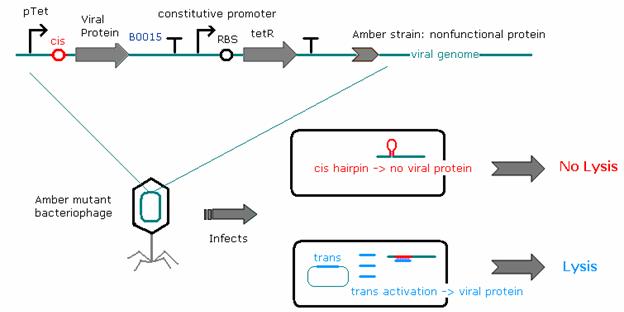The Project
In brief, we aim to knock out a key developmental gene in bacteriophage λ (using recombineering) and then add back a new copy under riboregulation.
 An overview of the Caltech 2007 iGEM project. We knock out the native copy of a key developmental gene, then add in a second copy under riboregulated control. Infection will only proceed in cells with the correct trans-activating RNA 'key'. Results
Riboregulation
Several combinations of cis-repressing and trans-activating RNA have been constructed. One combination has been shown to successfully regulate YFP expression. cis-repression reduced expression to 1% of unrepressed fluorescence. trans-activation then increased expression to 12% of unrepressed levels.
 Riboregulator results. cis-repression reduces expression to ~1% of unrepressed expression. trans-activation increases fluorescence 12-fold, to 12% of unregulated expression. Complementation
We tested our ability to complement amber mutants of bacteriophage λ using heterologously-expressed copies of the mutant gene. For two genes, N and Q, we were able to complement the corresponding amber mutant phage. However, we had sufficient leaky expression of both genes that we were unable to prevent complementation in cells carrying our construct, even in the absence of inducer. cis-repression of the heterologous Q was sufficient to prevent complementation, even in the presence of saturating inducer. So cis-repression can prevent complementation, and very little trans-activation will be necessary for lysis.
 Titering results. Heterologous N and Q were sufficient to complement the corresponding amber mutant phage. cis-repression of the heterologous Q reduced expression far enough to prevent complementation. |